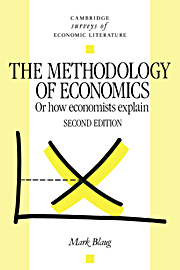Book contents
- Frontmatter
- Contents
- Preface
- Preface to first edition
- Part I What you always wanted to know about the philosophy of science but were afraid to ask
- Part II The history of economic methodology
- Part III A methodological appraisal of the neoclassical research program
- 6 The theory of consumer behavior
- 7 The theory of the firm
- 8 General equilibrium theory
- 9 Marginal productivity theory
- 10 Switching, reswitching, and all that
- 11 The Heckscher–Ohlin theory of international trade
- 12 Keynesians versus monetarists
- 13 Human capital theory
- 14 The new economics of the family
- 15 The rationality postulate
- Part IV What have we now learned about economics?
- Glossary
- Suggestions for further reading
- Bibliography
- Name index
- Subject index
14 - The new economics of the family
Published online by Cambridge University Press: 10 December 2009
- Frontmatter
- Contents
- Preface
- Preface to first edition
- Part I What you always wanted to know about the philosophy of science but were afraid to ask
- Part II The history of economic methodology
- Part III A methodological appraisal of the neoclassical research program
- 6 The theory of consumer behavior
- 7 The theory of the firm
- 8 General equilibrium theory
- 9 Marginal productivity theory
- 10 Switching, reswitching, and all that
- 11 The Heckscher–Ohlin theory of international trade
- 12 Keynesians versus monetarists
- 13 Human capital theory
- 14 The new economics of the family
- 15 The rationality postulate
- Part IV What have we now learned about economics?
- Glossary
- Suggestions for further reading
- Bibliography
- Name index
- Subject index
Summary
Household production functions
The Chicago theory of the maximizing family, sometimes referred to as the new home economics, furnishes us with our last specific illustration of methodological principles. From Gary Becker's 1965 article on the allocation of time and earlier work by Jacob Mincer and Becker on fertility rates, human capital formation, and the labor force participation rates of married women, a wide-ranging research program has been developed that gives a unified interpretation to all the diverse market and nonmarket activities of families: the initial decision to marry, the decision to have children, the division of household tasks between husband and wife, the extent of participation in the labor market and even the final decision to dissolve the family by divorce.
Traditional theory views the family as a one-person household, maximizing a utility function that is defined on goods and services bought in the marketplace. The new economics of the family instead views the family as a multiperson production unit, maximizing a production function whose inputs are market goods and the time, skills, and knowledge of different members of the family. The result is not only to extend the standard tools of microeconomics to problems usually assigned to the domain of sociology, social psychology, and social anthropology but to transform the traditional explanation of consumer behavior.
- Type
- Chapter
- Information
- The Methodology of EconomicsOr, How Economists Explain, pp. 220 - 228Publisher: Cambridge University PressPrint publication year: 1992

